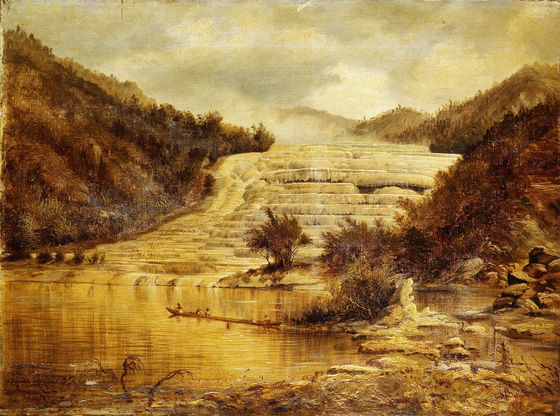"The eighth wonder of the world" that should have been lost by the volcanic eruption Pink terrace & white terrace may be buried in volcanic ash

The Terraces, 1885, by Charles Blomfield. Purchased 1946. Te Papa (1992-0035-1647)
Although it was once honored as "the eighth wonder of the world", it was thought that it was lost by volcanic eruption New Zealand's scenic spot "Pink terrace & white terrace". It was "rediscovered" that it was sinking to the bottom of the lake in the 2011 survey, but it was later concluded that the majority were destroyed by the effect of the eruption later. However, researchers have reported that they have identified the location of the terrace in a survey based on new materials.
Forensic cartography with Hochstetter's 1859 Pink and White Terraces survey: Te Otukapuarangi and Te Tarata: Journal of the Royal Society of New Zealand: Vol 0, No 0
http://www.tandfonline.com/doi/abs/10.1080/03036758.2017.1329748
Lost natural wonder in New Zealand may be found, say researchers | World news | The Guardian
https://www.theguardian.com/world/2017/jun/12/lost-natural-wonder-in-new-zealand-may-be-found-say-researchers

In the northern part of the North Island of New Zealand · North Island there is a hot spring called "Pink Terrace & White Terrace" on the shore of Lotmahana, known as a scenic spot.
It was formed by hot water with saturated silicic acid (silica) saturated with geothermal energy as the name contained in the name, the white terrace is 30 hectares wide and the height difference is 30 m, height difference is 30 m, pink terrace It seems that bathing was possible because low temperature was at the proper temperature. From Maori, New Zealand's indigenous people, the pink terrace was called "Te Otukapuarangi" (hot spring of the sea of clouds), the white terrace was called "Te Tarata" (tattoo rock).
A pink terrace that New Zealand painter Charles Bromfield painted in 1885

The Terraces (the pink terraces), 1885, by Charles Blomfield. Purchased 1946. Te Papa (1992-0035-1649)
White Terrace also drawn by Bromfield in 1885

The Terraces (the white terraces), 1885, by Charles Blomfield. Purchased 1946. Te Papa (1992-0035-1648)
It is said that the Europeans who visited this area for the first time are Ernst Deefenbach, a German naturalist and explorer. He explored New Zealand from 1841 to 1842 and wrote a book called "New Zealand Travel" in 1843 and mentioned the pink terrace and the white terrace in it. The European people who visited New Zealand seemed to be a rumored scenic spot, and the New Zealand Tourism Bureau told the terrace "New Zealand's first sightseeing"I express it. From all over the world, people came to New Zealand by boat, come to visit the terrace through further 150km of the road, "The eighth wonder of the world"It was also honored.
By the way, the eighth wonder of the world is "Seven Wonders of the World"A word that refers to a building etc. If you say "the seven wonders of the world", there may be some people who feel uncomfortable that the scent of "super civilization" like something, including the Great pyramid of Giza, appears as the second scenic spot after scenic spots , But the original material is "Seven of the world's landscape" written by inventor Byzantium Firon. Seven Wonders of the World "in English is translated as" the seven wonders of the world ", so it only has strange nuances, originally a meaning of" must see "" wonderful thing ".
The success of the pink terrace & white terrace will end with the eruption of the mountain of Tarawara located in the northeast of the lake on the evening of 10th June 1886. The seven surrounding villages were swallowed, the lake was interrupted by the flow path, the water level rose by 40 m, it became 20 times as large as before. Pink terrace and white terrace were also thought to be lost in this eruption.
It was in 2011 that the terrace was "rediscovered" from the bottom of the lake. A researcher found a lake bottom survey conducted in February using an autonomous unmanned submersible (AUV), which seems to be a part of a pink terrace under a layer of mud with a depth of 50 to 60 m. In addition, I found part of the white terrace in June.

By Julian Thomson, GNS Science
However, considering the rising water level and the place where the terrace was in response to this rediscovery, since the terrace should be found at about 10 m in depth, what was found in the survey was honored as "the eighth wonder of the world" in the 19th century There was an indication that it is not a terrace that was a terrace but a prehistoric terrace. For this reason, researchers examined the contents over five years, and again concluded that the terrace was largely destroyed by the eruption.
Multi-pronged investigation lays out the latest word on Lake Rotomahana - 10/04/2016 / Media Releases / News and Events / Home - GNS Science
https://www.gns.cri.nz/Home/News-and-Events/Media-Releases/Multi-pronged-investigation-lays-out-the-latest-word-on-Lake-Rotomahana-10-04-2016

After that, Mr. Rex van and Sasha Norden who newly researched are geologistsFerdinand · von · hohoshuteterI focused on the survey map of Lake Rotmahana in April 1859. This was what Hohoshuta wrote in the diary, the diary was kept by descendants, and in 2010 Norden discovered it in the basement.
Mr. Ban and Norden estimate places called "black terrace · crater" and "te · aliki datum" from the survey map. After verification by waterways, valleys and vegetation, the terrace was found not covered at the bottom of the lake but in the place covered by volcanic ash from 10 m to 15 m.
Mr. Ban and Mr. Norden insist on excavations, but because of the accuracy of the Hohoshuteter's survey map and verification of the authenticity of the diary, as well as the local landowners and policies of the New Zealand government, It does not seem to be able to move on to a step.
Related Posts:
in Science, Posted by logc_nt







